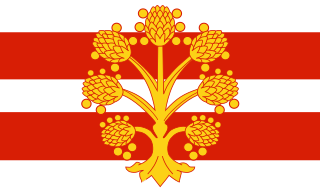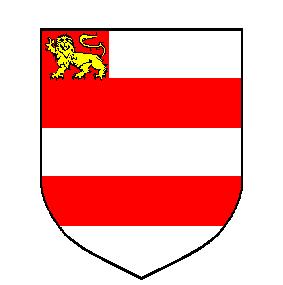
Westmorland is a historic county in Northern England.

Kendal, once Kirkby in Kendal or Kirkby Kendal, is a market town and civil parish in the Westmorland and Furness district of Cumbria, England. It lies within the River Kent's dale, from which its name is derived, just outside the boundary of the Lake District National Park.

Lancashire is a county of England, in the northwest of the country. The county did not exist in 1086, for the Domesday Book, and was apparently first created in 1182, making it one of the youngest of the traditional counties.

The Barony of Kendal is a subdivision of the English historic county of Westmorland. It evolved from one of two ancient baronies that make up the county, the other being the Barony of Westmorland. In 1974, the entire county became part of the modern county of Cumbria and ceased to have an administrative function. At the same time, Kendal borough along with some other rural and urban districts in Westmorland was merged with the neighbouring parts of Lancashire, Furness and Cartmel, and also the Sedbergh Rural District of the West Riding of Yorkshire into the new South Lakeland district of the new county.
The Barony of Westmorland also known as North Westmorland, the Barony of Appleby, Appleshire or the Bottom of Westmorland, was one of two baronies making up the English historical county of Westmorland, the other being the Barony of Kendal. Both of them evolved from medieval feudal baronies. Geographically, the barony covered the northern part of the larger county of the same name, and was divided into two wards – East Ward and West Ward. It covered an area similar to that of the former Eden District of the new county of Cumbria, although it did not include Penrith, which was the administrative capital of the district.

de Lacy is the surname of an old Norman family which originated from Lassy, Calvados. The family took part in the Norman Conquest of England and the later Norman invasion of Ireland. The name is first recorded for Hugh de Lacy (1020–1085). His sons, Walter and Ilbert, left Normandy and travelled to England with William the Conqueror. The awards of land by the Conqueror to the de Lacy sons led to two distinct branches of the family: the northern branch, centred on Blackburnshire and west Yorkshire was held by Ilbert's descendants; the southern branch of Marcher Lords, centred on Herefordshire and Shropshire, was held by Walter's descendants.
Ivo Taillebois was a powerful Norman nobleman, sheriff and tenant-in-chief in 11th-century England.
Westmorland in North West England was abolished in 1974 following Ted Heath's Local Government Act 1972. Westmorland became a part of Cumbria along with Cumberland, parts of Yorkshire and Lancashire, including the Furness peninsular. In 2022 Westmorland was reconstituted as Westmorland and Furness following the abolition of Cumbria County Council. Westmorland and Furness have no High Sheriff as Cumbria has remained the ceremonial county.

Kendal Parish Church, also known as the Holy Trinity Church due to its dedication to the Holy Trinity, is the Anglican parish church of Kendal, Cumbria, England. It is recorded in the National Heritage List for England as a designated Grade I listed building.
Ranulf le Meschin, 3rd Earl of Chester (1070–1129) was a Norman magnate based in northern and central England. Originating in Bessin in Normandy, Ranulf made his career in England thanks to his kinship with Hugh d'Avranches - the Earl of Chester, the patronage of kings William II Rufus and Henry I Beauclerc, and his marriage to Lucy, heiress of the Bolingbroke-Spalding estates in Lincolnshire.
Lucy of Bolingbroke or Lucia Thoroldsdottir of Lincoln was an Anglo-Norman heiress in central England and, later in life, countess of Chester. Probably related to the old English earls of Mercia, she came to possess extensive lands in Lincolnshire which she passed on to her husbands and sons. She was a notable religious patron, founding or co-founding two small religious houses and endowing several with lands and churches.
Robert III de Stuteville was an English baron and justiciar.

Gilbert fitz Roger fitz Reinfried, or Gilbert the son of Roger fitzReinfrid, was an Anglo-Norman feudal baron whose administrative career in England began in the time of Henry II (1154-1189), for whom his father Roger fitzReinfrid had been steward, and continued during the reigns of Richard I, King John, and Henry III.

The history of medieval Cumbria has several points of interest. The region's status as a borderland coping with 400 years of warfare is one. The attitude of the English central government, at once uninterested and deeply interested, is another. As a border region, of geopolitical importance, Cumbria changed hands between the Angles, Norse, Strathclyde Brythons, Picts, Normans, Scots and English; and the emergence of the modern county is also worthy of study.
The feudal barony of Curry Mallet was an English feudal barony with its caput at Curry Mallet Castle in Somerset, about 7 miles east of Taunton.

Sir James Leyburn, also Laybourne, Labourn, etc., was a senior representative of one of the powerful families within the Barony of Kendal. He was at different times a Justice of the Peace for Westmorland, Escheator for Cumberland and Westmorland, and Commissioner for the survey of the monasteries of Lancashire. He was caught up in the troubles at Kendal during the Pilgrimage of Grace (1536-1537). As an assistant to Sir Thomas Wharton, Deputy Warden of the West March, he took an important part in the Battle of Solway Moss (1542). He was one of the two MPs for Westmorland in 1542 and 1545.

The Constable of Chester was a mediaeval hereditary office held by the Barons of Halton. The functions of the Constable are unclear, possibly they related to the custody of Chester Castle, as was the main function of most mediaeval constables, but Sanders (1960) says the office-holder was constable for the entire County Palatine.
John de Lancaster of Grisedale and Stanstead was an English knight, and a parliamentary baron in the Peerage of England. He was the first and last in his line to be called to parliament, as he had no heir. He was therefore the only "Lord Lancaster" or "Baron Lancaster" apart from the separate titles which belonged to a branch of the royal family descended from Edmund Crouchback. His father's family had many lordships in northwestern England, including Grisedale ; while his mother's family made him an heir to important lordships in other parts of England, including Stansted Mountfitchet in Essex.
Hugh de Morville Baron of Burgh, Lord of Kirkoswald, was an English noble.
William Ecroyd Farrer was an English historian and genealogist.










